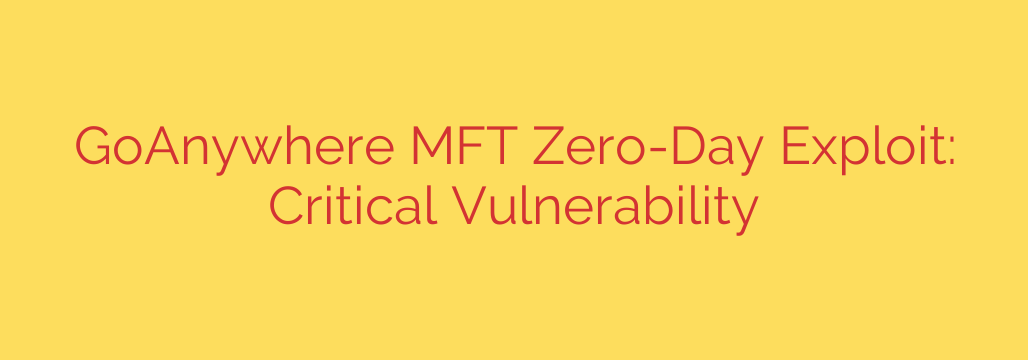
Understanding the Critical GoAnywhere MFT Vulnerability (CVE-2023-0669)
In the world of cybersecurity, zero-day vulnerabilities represent a significant threat, and a critical flaw discovered in Fortra’s GoAnywhere MFT (Managed File Transfer) software is a stark reminder of this danger. This vulnerability, tracked as CVE-2023-0669, is a severe pre-authentication remote code execution (RCE) issue that allows attackers to compromise systems without needing a username or password.
Due to its severity and active exploitation by threat actors, understanding this vulnerability and taking immediate action is crucial for any organization using the GoAnywhere MFT platform.
What is the GoAnywhere MFT Vulnerability?
At its core, CVE-2023-0669 is a deserialization vulnerability. It allows a remote, unauthenticated attacker to execute arbitrary code on a vulnerable GoAnywhere MFT instance. The primary attack vector for this exploit is the publicly exposed administrative console. If an organization’s GoAnywhere administrative port is accessible from the internet, it is at high risk of compromise.
The ability for an attacker to achieve remote code execution is a worst-case scenario. It essentially gives them the keys to the kingdom, allowing them to install malware, steal data, create new administrative users, and move laterally across the network.
The Impact: Data Exfiltration and Ransomware Attacks
This is not a theoretical threat. The GoAnywhere MFT vulnerability has been actively and widely exploited by cybercriminal groups, most notably the Clop ransomware gang (also known as TA505). This group is known for targeting file transfer solutions to execute large-scale data theft campaigns.
Their typical method involves:
- Exploiting the vulnerability to gain initial access to the server.
- Exfiltrating large volumes of sensitive data stored on the MFT platform.
- Deploying ransomware or, more commonly, engaging in extortion by threatening to publish the stolen data if a ransom is not paid.
The consequences of a successful attack are severe, including massive data breaches affecting hundreds of organizations, significant financial losses, reputational damage, and major operational disruptions.
Actionable Steps to Protect Your Systems
If your organization uses GoAnywhere MFT, immediate and decisive action is required to mitigate this threat. Waiting is not an option, as automated scans for vulnerable systems are constantly running.
Here are the essential security measures you must take:
Patch Immediately: The most critical step is to update your software. Fortra has released a patch to fix this vulnerability. All users should upgrade to GoAnywhere MFT version 7.1.2 or a later version as soon as possible to fully remediate the flaw.
Restrict Access to the Admin Console: As a fundamental security best practice, administrative interfaces should never be exposed to the public internet. If you cannot patch immediately, implement firewall rules or other network controls to ensure the administrative port is only accessible from trusted IP addresses or via a secure VPN. This step alone significantly reduces your attack surface.
Hunt for Indicators of Compromise (IOCs): Since this vulnerability has been exploited in the wild, it is vital to check your systems for signs of a breach. Security teams should review server logs for suspicious activity, look for unexpected new user accounts (especially in the admin console), and scan for malicious files or scripts placed on the server. A common indicator was the presence of new files in the
webapps/goanywhere/directory on compromised systems.
A Proactive Stance on Security is Non-Negotiable
The GoAnywhere MFT zero-day event underscores a critical lesson for modern enterprises: proactive security is not optional. The widespread use of secure file transfer solutions makes them a high-value target for attackers seeking to steal sensitive data.
Organizations must prioritize robust patch management protocols, enforce the principle of least privilege, and actively work to minimize their external attack surface. Regularly auditing the security of internet-facing applications and promptly addressing vulnerabilities is the only way to stay ahead of sophisticated threat actors.
Source: https://www.bleepingcomputer.com/news/security/maximum-severity-goanywhere-mft-flaw-exploited-as-zero-day/








